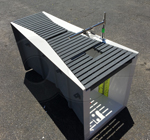 When installed in manholes or potential pedestrian traffic areas, flow monitoring flumes can be a hazard. A typical flume installation is an open trough that that an operator can inadvertently step or fall into.
When installed in manholes or potential pedestrian traffic areas, flow monitoring flumes can be a hazard. A typical flume installation is an open trough that that an operator can inadvertently step or fall into.
 When installed in manholes or potential pedestrian traffic areas, flow monitoring flumes can be a hazard. A typical flume installation is an open trough that that an operator can inadvertently step or fall into.
When installed in manholes or potential pedestrian traffic areas, flow monitoring flumes can be a hazard. A typical flume installation is an open trough that that an operator can inadvertently step or fall into.





